Once you have created an email account in C-Panel or Direct Admin, you will need to create a corresponding account in your mail program. Although this tutorial is written specifically for Outlook, you will find that the procedure is very similar for other versions of Outlook, Outlook Express or even other mail clients such as Thunderbird or Eudora. Just be aware that some of the labels and buttons might be different.
Step 1: Open Outlook , click File in the top menu.
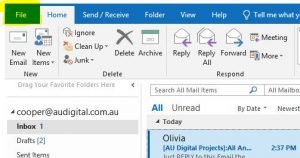
Step 2: Click on the Add Account Button
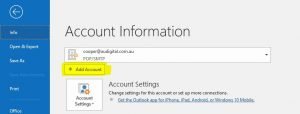
Step 3: Enter in your Email account in the text box and click Advanced Options and check the box that says ‘Let me set up my account manually’ the click Connect
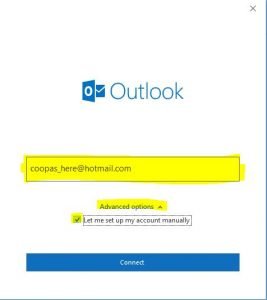
Step 4: Select POP3.
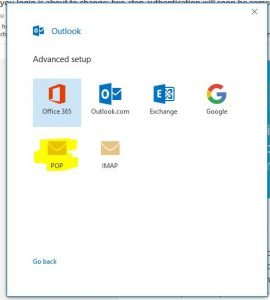
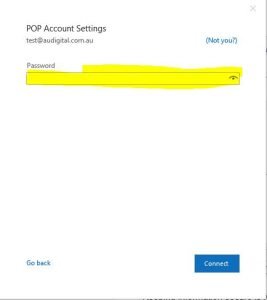
- Incoming mail server: Enter mail.Your Domain.com for example; AU Digital mail server is mail.audigital.com.au.
- Outgoing mail server (SMTP): Your outgoing mail server should be that of your ISP. If in doubt, check with your ISP. (Internet Service Provider). For example; mail.your-isp-name.com.au (SMTP). This method can save your hosting account allotted bandwidth limit (recommended). For a list of ISPs check down below. This method can save your hosting account allotted bandwidth limit (recommended)
OR (Alternatively)
Outgoing Mail server: mail.your-domain-name.com.au (SMTP) same as incoming mail server.
Ports
- Incoming Ports
- SSL(recommended) – For your incoming server you will want to set the port 995. You will need to make sure SSL is enabled. It should be an option just below the port number box it is either a drop down or a check box. Always select SSL/TLS.
- Non SSL – For your incoming server you will want to set this to 110.
- Outgoing Ports
- SSL(recommended) – For your outgoing server you will want to set the port to 465. You will need to make sure SSL is enabled. It should be an option just below the port number box it is either a drop down or a check box. Always select SSL/TLS.
- Non SSL – For your outgoing server you will want to set this to 25 or 587.
- User Name: Your username will be your entire email address. (Please be sure to use the whole address as if you were sending an email to yourself)
- Password: Enter the password you set up when you created the mailbox within your control panel.
- Remember password: Check this box.
- Require logon using secure password authentication (SPA): Leave unchecked.

1. Use your own ISPs (Internet service provider) outgoing mail server1 (SMTP). (Recommended2)
ISP smtp infomation
The easiest way to find your outgoing mail server is to contact your ISP.
Some common ISP Outgoing Mail Servers are as follows – typically your username for these servers is your email account (i.e. yourname@isp.com) and associated password:
Outgoing Mail Server
Who is your Internet provider?
| Internet Provider | Outgoing Mail Server |
|---|---|
| AAPT | mail.aapt.net.au |
| iiNet | mail.iinet.net.au |
| Internode | mail.internode.on.net |
| iPrimus | smtp.iprimus.com.au |
| OptusNet | mail.optusnet.com.au |
| Telstra Bigpond | mail.bigpond.com |
| TPG | mail.tpg.com.au |
| Vodaphone | smtp.vodafone.net.au |
If your ISP is not here then search online for your ISP outgoing mail address
*We provide this list as a service to our customers but cannot guarantee that this list will always be up to date.
POP
- Best when you will be primarily accessing your email from a single location, like your office or home. When you leave your office or home, you can still access your email from a web browser.
- Messages are downloaded to your computer, so you don’t need to worry about exceeding the size of your mailbox.
- When accessing your email account through a web browser, you may not see previous messages that were downloaded to your desktop email client.
IMAP
- Best when you will be accessing your email from multiple locations.
- Allows you to create portable folders. These folders will appear in each email client you use to access your account. Your account will look the same at work, at home, and at your friend’s house.
- Because your email messages are stored on the server, you must monitor your mailbox size and delete messages to avoid exceeding your mailbox size.